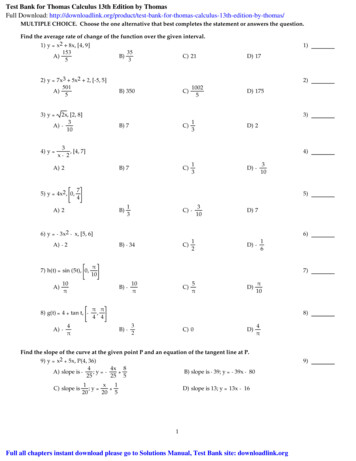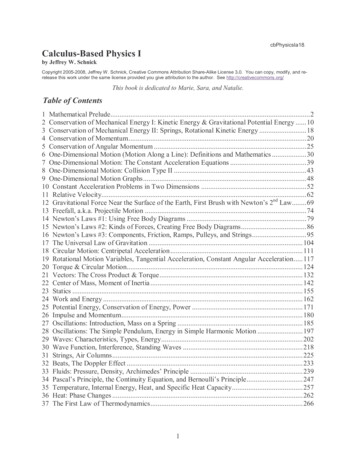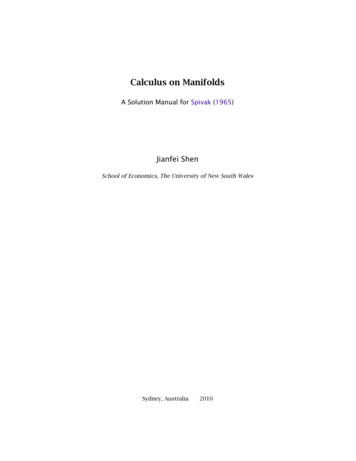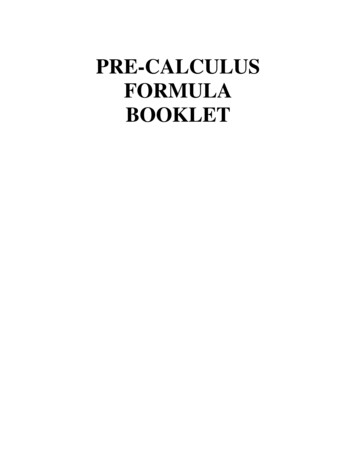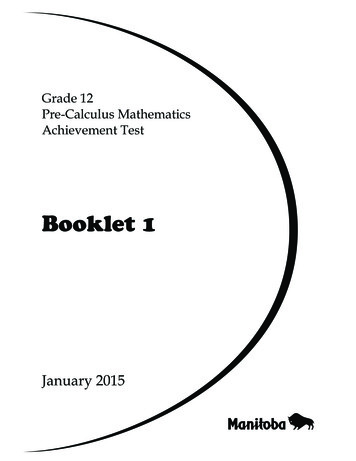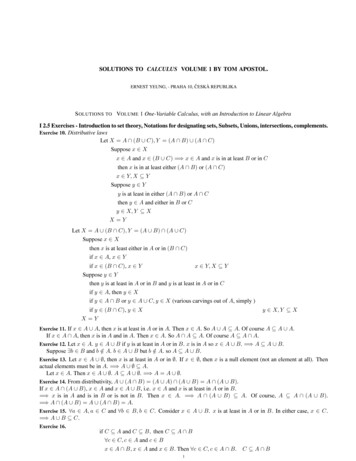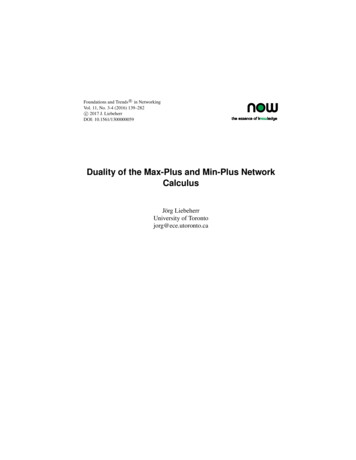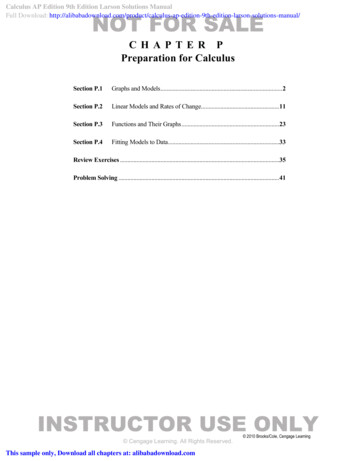
Transcription
Calculus IIFORDUMmIES‰by Mark Zegarelli
Calculus II For Dummies Published byWiley Publishing, Inc.111 River St.Hoboken, NJ 07030-5774www.wiley.comCopyright 2008 by Wiley Publishing, Inc., Indianapolis, IndianaPublished simultaneously in CanadaNo part of this publication may be reproduced, stored in a retrieval system, or transmitted in any formor by any means, electronic, mechanical, photocopying, recording, scanning, or otherwise, except as permitted under Sections 107 or 108 of the 1976 United States Copyright Act, without either the prior writtenpermission of the Publisher, or authorization through payment of the appropriate per-copy fee to theCopyright Clearance Center, 222 Rosewood Drive, Danvers, MA 01923, 978-750-8400, fax 978-646-8600.Requests to the Publisher for permission should be addressed to the Legal Department, Wiley Publishing,Inc., 10475 Crosspoint Blvd., Indianapolis, IN 46256, 317-572-3447, fax 317-572-4355, or online athttp://www.wiley.com/go/permissions.Trademarks: Wiley, the Wiley Publishing logo, For Dummies, the Dummies Man logo, A Reference for theRest of Us!, The Dummies Way, Dummies Daily, The Fun and Easy Way, Dummies.com and related tradedress are trademarks or registered trademarks of John Wiley & Sons, Inc. and/or its affiliates in the UnitedStates and other countries, and may not be used without written permission. All other trademarks are theproperty of their respective owners. Wiley Publishing, Inc., is not associated with any product or vendormentioned in this book.LIMIT OF LIABILITY/DISCLAIMER OF WARRANTY: THE PUBLISHER AND THE AUTHOR MAKE NO REPRESENTATIONS OR WARRANTIES WITH RESPECT TO THE ACCURACY OR COMPLETENESS OF THE CONTENTS OF THIS WORK AND SPECIFICALLY DISCLAIM ALL WARRANTIES, INCLUDING WITHOUTLIMITATION WARRANTIES OF FITNESS FOR A PARTICULAR PURPOSE. NO WARRANTY MAY BE CREATED OR EXTENDED BY SALES OR PROMOTIONAL MATERIALS. THE ADVICE AND STRATEGIES CONTAINED HEREIN MAY NOT BE SUITABLE FOR EVERY SITUATION. THIS WORK IS SOLD WITH THEUNDERSTANDING THAT THE PUBLISHER IS NOT ENGAGED IN RENDERING LEGAL, ACCOUNTING, OROTHER PROFESSIONAL SERVICES. IF PROFESSIONAL ASSISTANCE IS REQUIRED, THE SERVICES OF ACOMPETENT PROFESSIONAL PERSON SHOULD BE SOUGHT. NEITHER THE PUBLISHER NOR THEAUTHOR SHALL BE LIABLE FOR DAMAGES ARISING HEREFROM. THE FACT THAT AN ORGANIZATIONOR WEBSITE IS REFERRED TO IN THIS WORK AS A CITATION AND/OR A POTENTIAL SOURCE OF FURTHER INFORMATION DOES NOT MEAN THAT THE AUTHOR OR THE PUBLISHER ENDORSES THE INFORMATION THE ORGANIZATION OR WEBSITE MAY PROVIDE OR RECOMMENDATIONS IT MAY MAKE.FURTHER, READERS SHOULD BE AWARE THAT INTERNET WEBSITES LISTED IN THIS WORK MAY HAVECHANGED OR DISAPPEARED BETWEEN WHEN THIS WORK WAS WRITTEN AND WHEN IT IS READ.For general information on our other products and services, please contact our Customer CareDepartment within the U.S. at 800-762-2974, outside the U.S. at 317-572-3993, or fax 317-572-4002.For technical support, please visit www.wiley.com/techsupport.Wiley also publishes its books in a variety of electronic formats. Some content that appears in print maynot be available in electronic books.Library of Congress Control Number: 2008925786ISBN: 978-0-470-22522-6Manufactured in the United States of America10 9 8 7 6 5 4 3 2 1
About the AuthorMark Zegarelli is the author of Logic For Dummies (Wiley), Basic Math &Pre-Algebra For Dummies (Wiley), and numerous books of puzzles. He holdsdegrees in both English and math from Rutgers University, and lives in LongBranch, New Jersey, and San Francisco, California.DedicationFor my brilliant and beautiful sister, Tami. You are an inspiration.Author’s AcknowledgmentsMany thanks for the editorial guidance and wisdom of Lindsay Lefevere,Stephen Clark, and Sarah Faulkner of Wiley Publishing. Thanks also to theTechnical Editor, Jeffrey A. Oaks, PhD. Thanks especially to my friend DavidNacin, PhD, for his shrewd guidance and technical assistance.Much love and thanks to my family: Dr. Anthony and Christine Zegarelli,Mary Lou and Alan Cary, Joe and Jasmine Cianflone, and Deseret MoctezumaRackham and Janet Rackham. Thanksgiving is at my place this year!And, as always, thank you to my partner, Mark Dembrowski, for your constant wisdom, support, and love.
Publisher’s AcknowledgmentsWe’re proud of this book; please send us your comments through our Dummies online registrationform located at www.dummies.com/register/.Some of the people who helped bring this book to market include the following:Acquisitions, Editorial, and MediaDevelopmentComposition ServicesProject Coordinator: Katie KeyProject Editor: Stephen R. ClarkLayout and Graphics: Carrie A. CesaviceAcquisitions Editor: Lindsay Sandman LefevereProofreaders: Laura Albert, Laura L. BowmanSenior Copy Editor: Sarah FaulknerIndexer: Broccoli Information ManagementEditorial Program Coordinator:Erin Calligan MooneySpecial HelpTechnical Editor: Jeffrey A. Oaks, PhDDavid Nacin, PhDEditorial Manager: Christine Meloy BeckEditorial Assistants: Joe Niesen, David LuttonCover Photos: ComstockCartoons: Rich Tennant(www.the5thwave.com)Publishing and Editorial for Consumer DummiesDiane Graves Steele, Vice President and Publisher, Consumer DummiesJoyce Pepple, Acquisitions Director, Consumer DummiesKristin A. Cocks, Product Development Director, Consumer DummiesMichael Spring, Vice President and Publisher, TravelKelly Regan, Editorial Director, TravelPublishing for Technology DummiesAndy Cummings, Vice President and Publisher, Dummies Technology/General UserComposition ServicesGerry Fahey, Vice President of Production ServicesDebbie Stailey, Director of Composition Services
Contents at a GlanceIntroduction .1Part I: Introduction to Integration .9Chapter 1: An Aerial View of the Area Problem .11Chapter 2: Dispelling Ghosts from the Past:A Review of Pre-Calculus and Calculus I .37Chapter 3: From Definite to Indefinite: The Indefinite Integral .73Part II: Indefinite Integrals .103Chapter 4: Instant Integration: Just Add Water (And C) .105Chapter 5: Making a Fast Switch: Variable Substitution .117Chapter 6: Integration by Parts .135Chapter 7: Trig Substitution: Knowing All the (Tri)Angles .151Chapter 8: When All Else Fails: Integration with Partial Fractions .173Part III: Intermediate Integration Topics .195Chapter 9: Forging into New Areas: Solving Area Problems .197Chapter 10: Pump up the Volume: Using Calculus to Solve 3-D Problems .219Part IV: Infinite Series .241Chapter 11: Following a Sequence, Winning the Series .243Chapter 12: Where Is This Going? Testing for Convergence and Divergence .261Chapter 13: Dressing up Functions with the Taylor Series .283Part V: Advanced Topics .305Chapter 14: Multivariable Calculus .307Chapter 15: What’s So Different about Differential Equations? .327Part VI: The Part of Tens .341Chapter 16: Ten “Aha!” Insights in Calculus II .343Chapter 17: Ten Tips to Take to the Test .349Index .353
Table of ContentsIntroduction.1About This Book .1Conventions Used in This Book .3What You’re Not to Read .3Foolish Assumptions .3How This Book Is Organized .4Part I: Introduction to Integration .4Part II: Indefinite Integrals .4Part III: Intermediate Integration Topics .5Part IV: Infinite Series .5Part V: Advanced Topics .6Part VI: The Part of Tens .7Icons Used in This Book .7Where to Go from Here .8Part I: Introduction to Integration .9Chapter 1: An Aerial View of the Area Problem . . . . . . . . . . . . . . . . . .11Checking out the Area .12Comparing classical and analytic geometry .12Discovering a new area of study .13Generalizing the area problem .15Finding definite answers with the definite integral .16Slicing Things Up .19Untangling a hairy problem by using rectangles .20Building a formula for finding area .22Defining the Indefinite .27Solving Problems with Integration .28We can work it out: Finding the area between curves .29Walking the long and winding road .29You say you want a revolution .30Understanding Infinite Series .31Distinguishing sequences and series .31Evaluating series .32Identifying convergent and divergent series .32Advancing Forward into Advanced Math .33Multivariable calculus .33Differential equations .34Fourier analysis .34Numerical analysis .34
viiiCalculus II For DummiesChapter 2: Dispelling Ghosts from the Past:A Review of Pre-Calculus and Calculus I . . . . . . . . . . . . . . . . . . . . . . .37Forgotten but Not Gone: A Review of Pre-Calculus .38Knowing the facts on factorials .38Polishing off polynomials .39Powering through powers (exponents) .39Noting trig notation .41Figuring the angles with radians .42Graphing common functions .43Asymptotes .47Transforming continuous functions .47Identifying some important trig identities .48Polar coordinates .50Summing up sigma notation .51Recent Memories: A Review of Calculus I .53Knowing your limits .53Hitting the slopes with derivatives .55Referring to the limit formula for derivatives .56Knowing two notations for derivatives .56Understanding differentiation .57Finding Limits by Using L’Hospital’s Rule .64Understanding determinate and indeterminate forms of limits .65Introducing L’Hospital’s Rule .66Alternative indeterminate forms .68Chapter 3: From Definite to Indefinite: The Indefinite Integral . . . . .73Approximate Integration .74Three ways to approximate area with rectangles .74The slack factor .78Two more ways to approximate area .79Knowing Sum-Thing about Summation Formulas .83The summation formula for counting numbers .83The summation formula for square numbers .84The summation formula for cubic numbers .84As Bad as It Gets: Calculating Definite Integrals byUsing the Riemann Sum Formula .85Plugging in the limits of integration .86Expressing the function as a sum in terms of i and n .86Calculating the sum .88Solving the problem with a summation formula .88Evaluating the limit .89Light at the End of the Tunnel: The FundamentalTheorem of Calculus .89
Table of ContentsUnderstanding the Fundamental Theorem of Calculus .91What’s slope got to do with it? .92Introducing the area function .92Connecting slope and area mathematically .94Seeing a dark side of the FTC .95Your New Best Friend: The Indefinite Integral .95Introducing anti-differentiation .96Solving area problems without the Riemann sum formula .97Understanding signed area .99Distinguishing definite and indefinite integrals .101Part II: Indefinite Integrals .103Chapter 4: Instant Integration: Just Add Water (And C) . . . . . . . . . .105Evaluating Basic Integrals .106Using the 17 basic anti-derivatives for integrating .106Three important integration rules .107What happened to the other rules? .110Evaluating More Difficult Integrals .110Integrating polynomials .110Integrating rational expressions .111Using identities to integrate trig functions .112Understanding Integrability .113Understanding two red herrings of integrability .114Understanding what integrable really means .115Chapter 5: Making a Fast Switch: Variable Substitution . . . . . . . . .117Knowing How to Use Variable Substitution .118Finding the integral of nested functions .118Finding the integral of a product .120Integrating a function multipliedby a set of nested functions .121Recognizing When to Use Substitution .123Integrating nested functions .123Knowing a shortcut for nested functions .125Substitution when one part of a functiondifferentiates to the other part .129Using Substitution to Evaluate Definite Integrals .132Chapter 6: Integration by Parts . . . . . . . . . . . . . . . . . . . . . . . . . . . . . . . .135Introducing Integration by Parts .135Reversing the Product Rule .136Knowing how to integrate by parts .137Knowing when to integrate by parts .138ix
xCalculus II For DummiesIntegrating by Parts with the DI-agonal Method .140Looking at the DI-agonal chart .140Using the DI-agonal method .140Chapter 7: Trig Substitution: KnowingAll the (Tri)Angles . . . . . . . . . . . . . . . . . . . . . . . . . . . . . . . . . . . . . . . . . . .151Integrating the Six Trig Functions .151Integrating Powers of Sines and Cosines .152Odd powers of sines and cosines .152Even powers of sines and cosines .154Integrating Powers of Tangents and Secants .155Even powers of secants with tangents .155Odd powers of tangents with secants .156Odd powers of tangents without secants .156Even powers of tangents without secants .156Even powers of secants without tangents .157Odd powers of secants without tangents .157Even powers of tangents with odd powers of secants .158Integrating Powers of Cotangents and Cosecants .159Integrating Weird Combinations of Trig Functions .160Using identities to tweak functions .160Using Trig Substitution .161Distinguishing three cases for trig substitution .162Integrating the three cases .163Knowing when to avoid trig substitution .171Chapter 8: When All Else Fails: Integrationwith Partial Fractions . . . . . . . . . . . . . . . . . . . . . . . . . . . . . . . . . . . . . . .173Strange but True: Understanding Partial Fractions .174Looking at partial fractions .174Using partial fractions with rational expressions .175Solving Integrals by Using Partial Fractions .176Setting up partial fractions case by case .177Knowing the ABCs of finding unknowns .181Integrating partial fractions .184Integrating Improper Rationals .187Distinguishing proper and improper rational expressions .187Recalling polynomial division .188Trying out an example .191Part III: Intermediate Integration Topics .195Chapter 9: Forging into New Areas: Solving Area Problems . . . . . .197Breaking Us in Two .198Improper Integrals .199Getting horizontal .199Going vertical .201
Table of ContentsSolving Area Problems with More Than One Function .204Finding the area under more than one function .205Finding the area between two functions .206Looking for a sign .209Measuring unsigned area between curves with a quick trick .211The Mean Value Theorem for Integrals .213Calculating Arc Length .215Chapter 10: Pump up the Volume: Using Calculusto Solve 3-D Problems . . . . . . . . . . . . . . . . . . . . . . . . . . . . . . . . . . . . . . .219Slicing Your Way to Success .220Finding the volume of a solid with congruent cross sections .220Finding the volume of a solid with similar cross sections .221Measuring the volume of a pyramid .222Measuring the volume of a weird solid .224Turning a Problem on Its Side .225Two Revolutionary Problems .226Solidifying your understanding of solids of revolution .227Skimming the surface of revolution .229Finding the Space Between .230Playing the Shell Game .234Peeling and measuring a can of soup .235Using the shell method .236Knowing When and How to Solve 3-D Problems .238Part IV: Infinite Series .241Chapter 11: Following a Sequence, Winning the Series . . . . . . . . . .243Introducing Infinite Sequences .244Understanding notations for sequences .244Looking at converging and diverging sequences .245Introducing Infinite Series .247Getting Comfy with Sigma Notation .249Writing sigma notation in expanded form .249Seeing more than one way to use sigma notation .250Discovering the Constant Multiple Rule for series .250Examining the Sum Rule for series .251Connecting a Series with Its Two Related Sequences .252A series and its defining sequence .252A series and its sequences of partial sums .253Recognizing Geometric Series and P-Series .254Getting geometric series .255Pinpointing p-series .257xi
xiiCalculus II For DummiesChapter 12: Where Is This Going? Testing forConvergence and Divergence . . . . . . . . . . . . . . . . . . . . . . . . . . . . . . . .261Starting at the Beginning .262Using the nth-Term Test for Divergence .263Let Me Count the Ways .263One-way tests .263Two-way tests .264Using Comparison Tests .264Getting direct answers with the direct comparison test .265Testing your limits with the limit comparison test .267Two-Way Tests for Convergence and Divergence .270Integrating a solution with the integral test .270Rationally solving problems with the ratio test .273Rooting out answers with the root test .274Alternating Series .275Eyeballing two forms of the basic alternating series .276Making new series from old ones .276Alternating series based on convergent positive series .277Using the alternating series test .277Understanding absolute and conditional convergence .280Testing alternating series .281Chapter 13: Dressing up Functions with the Taylor Series . . . . . . . .283Elementary Functions .284Knowing two drawbacks of elementary functions .284Appreciating why polynomials are so friendly .285Representing elementary functions as polynomials .285Representing elementary functions as series .285Power Series: Polynomials on Steroids .286Integrating power series .287Understanding the interval of convergence .288Expressing Functions as Series .291Expressing sin x as a series .291Expressing cos x as a series .293Introducing the Maclaurin Series .293Introducing the Taylor Series .296Computing with the Taylor series .297Examining convergent and divergent Taylor series .298Expressing functions versus approximating functions .300Calculating error bounds for Taylor polynomials .301Understanding Why the Taylor Series Works .303
Table of ContentsPart V: Advanced Topics .305Chapter 14: Multivariable Calculus . . . . . . . . . . . . . . . . . . . . . . . . . . . .307Visualizing Vectors .308Understanding vector basics .308Distinguishing vectors and scalars .310Calculating with vectors .310Leaping to Another Dimension .
About the Author Mark Zegarelli is the author of Logic For Dummies (Wiley), Basic Math & Pre-Algebra For Dummies (Wiley), and numerous books of puzzles.He holds degrees in both Engl

